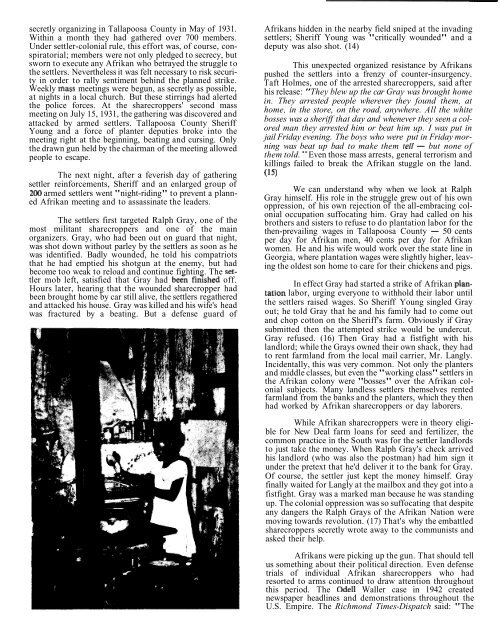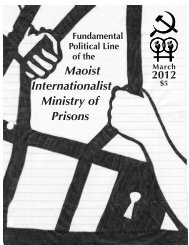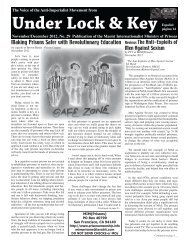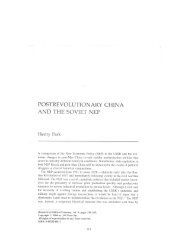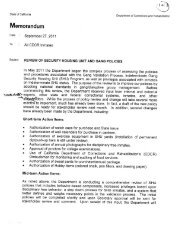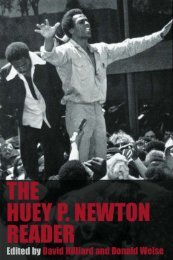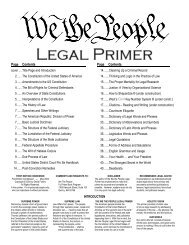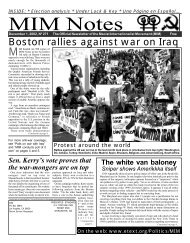Mythology of the White Proletariat - San Francisco Bay Area ...
Mythology of the White Proletariat - San Francisco Bay Area ...
Mythology of the White Proletariat - San Francisco Bay Area ...
You also want an ePaper? Increase the reach of your titles
YUMPU automatically turns print PDFs into web optimized ePapers that Google loves.
secretly organizing in Tallapoosa County in May <strong>of</strong> 193 1.<br />
Within a month <strong>the</strong>y had ga<strong>the</strong>red over 700 members.<br />
Under settler-colonial rule, this effort was, <strong>of</strong> course, conspiratorial;<br />
members were not only pledged to secrecy, but<br />
sworn to execute any Afrikan who betrayed <strong>the</strong> struggle to<br />
<strong>the</strong> settlers. Never<strong>the</strong>less it was felt necessary to risk security<br />
in order to rally sentiment behind <strong>the</strong> planned strike.<br />
Weekly niass meetings were begun, as secretly as possible,<br />
at nights in a local church. But <strong>the</strong>se stirrings had alerted<br />
<strong>the</strong> police forces. At <strong>the</strong> sharecroppers' second mass<br />
meeting on July 15, 1931, <strong>the</strong> ga<strong>the</strong>ring was discovered and<br />
attacked by armed settlers. Tallapoosa County Sheriff<br />
Young and a force <strong>of</strong> planter deputies broke into <strong>the</strong><br />
meeting right at <strong>the</strong> beginning, beating and cursing. Only<br />
<strong>the</strong> drawn gun held by <strong>the</strong> chairman <strong>of</strong> <strong>the</strong> meeting allowed<br />
people to escape.<br />
The next night, after a feverish day <strong>of</strong> ga<strong>the</strong>ring<br />
settler reinforcements, Sheriff and an enlarged group <strong>of</strong><br />
200 armed settlers went "night-riding" to prevent a planned<br />
Afrikan meeting and to assassinate <strong>the</strong> leaders.<br />
The settlers first targeted Ralph Gray, one <strong>of</strong> <strong>the</strong><br />
most militant sharecroppers and one <strong>of</strong> <strong>the</strong> main<br />
organizers. Gray, who had been out on guard that night,<br />
was shot down without parley by <strong>the</strong> settlers as soon as he<br />
was identified. Badly wounded, he told his compatriots<br />
that he had emptied his shotgun at <strong>the</strong> enemy, but had<br />
become too weak to reload and continue fighting. The settler<br />
mob left, satisfied that Gray had been finished <strong>of</strong>f.<br />
Hours later, hearing that <strong>the</strong> wounded sharecropper had<br />
been brought home by car still alive, <strong>the</strong> settlers rega<strong>the</strong>red<br />
and attacked his house. Gray was killed and his wife's head<br />
was fractured by a beating. But a defense guard <strong>of</strong><br />
Afrikans hidden in <strong>the</strong> nearby field sniped at <strong>the</strong> invading<br />
settlers; Sheriff Young was "critically wounded" and a<br />
deputy was also shot. (14)<br />
This unexpected organized resistance by Afrikans<br />
pushed <strong>the</strong> settlers into a frenzy <strong>of</strong> counter-insurgency.<br />
Taft Holmes, one <strong>of</strong> <strong>the</strong> arrested sharecroppers, said after<br />
his release: "They blew up <strong>the</strong> car Gray was brought home<br />
in. They arrested people wherever <strong>the</strong>y found <strong>the</strong>m, at<br />
home, in <strong>the</strong> store, on <strong>the</strong> road, anywhere. All <strong>the</strong> white<br />
bosses was a sheriff that day and whenever <strong>the</strong>y seen a colored<br />
man <strong>the</strong>y arrested him or beat him up. I was put in<br />
jail Friday evening. The boys who were put in Friday morning<br />
was beat up bad to make <strong>the</strong>m tell - but none <strong>of</strong><br />
<strong>the</strong>m told. " Even those mass arrests, general terrorism and<br />
killings failed to break <strong>the</strong> Afrikan stuggle on <strong>the</strong> land.<br />
(15)<br />
We can understand why when we look at Ralph<br />
Gray himself. His role in <strong>the</strong> struggle grew out <strong>of</strong> his own<br />
oppression, <strong>of</strong> his own rejection <strong>of</strong> <strong>the</strong> all-embracing colonial<br />
occupation suffocating him. Gray had called on his<br />
bro<strong>the</strong>rs and sisters to refuse to do plantation labor for <strong>the</strong><br />
<strong>the</strong>n-prevailing wages in Tallapoosa County - 50 cents<br />
per day for Afrikan men, 40 cents per day for Afrikan<br />
women. He and his wife would work over <strong>the</strong> state line in<br />
Georgia, where plantation wages were slightly higher, leaving<br />
<strong>the</strong> oldest son home to care for <strong>the</strong>ir chickens and pigs.<br />
In effect Gray had started a strike <strong>of</strong> Afrikan plantation<br />
labor, urging everyone to withhold <strong>the</strong>ir labor until<br />
<strong>the</strong> settlers raised wages. So Sheriff Young singled Gray<br />
out; he told Gray that he and his family had to come out<br />
and chop cotton on <strong>the</strong> Sheriff's farm. Obviously if Gray<br />
submitted <strong>the</strong>n <strong>the</strong> attempted strike would be undercut.<br />
Gray refused. (16) Then Gray had a fistfight with his<br />
landlord; while <strong>the</strong> Grays owned <strong>the</strong>ir own shack, <strong>the</strong>y had<br />
to rent farmland from <strong>the</strong> local mail carrier, Mr. Langly.<br />
Incidentally, this was very common. Not only <strong>the</strong> planters<br />
and middle classes, but even <strong>the</strong> "working class" settlers in<br />
<strong>the</strong> Afrikan colony were "bosses" over <strong>the</strong> Afrikan colonial<br />
subjects. Many landless settlers <strong>the</strong>mselves rented<br />
farmland from <strong>the</strong> banks and <strong>the</strong> planters, which <strong>the</strong>y <strong>the</strong>n<br />
had worked by Afrikan sharecroppers or day laborers.<br />
While Afrikan sharecroppers were in <strong>the</strong>ory eligible<br />
for New Deal farm loans for seed and fertilizer, <strong>the</strong><br />
common practice in <strong>the</strong> South was for <strong>the</strong> settler landlords<br />
to just take <strong>the</strong> money. When Ralph Gray's check arrived<br />
his landlord (who was also <strong>the</strong> postman) had him sign it<br />
under <strong>the</strong> pretext that he'd deliver it to <strong>the</strong> bank for Gray.<br />
Of course, <strong>the</strong> settler just kept <strong>the</strong> money himself. Gray<br />
finally waited for Langly at <strong>the</strong> mailbox and <strong>the</strong>y got into a<br />
fistfight. Gray was a marked man because he was standing<br />
up. The colonial oppression was so suffocating that despite<br />
any dangers <strong>the</strong> Ralph Grays <strong>of</strong> <strong>the</strong> Afrikan Nation were<br />
moving towards revolution. (17) That's why <strong>the</strong> embattled<br />
sharecroppers secretly wrote away to <strong>the</strong> communists and<br />
asked <strong>the</strong>ir help.<br />
Afrikans were picking up <strong>the</strong> gun. That should tell<br />
us something about <strong>the</strong>ir political direction. Even defense<br />
trials <strong>of</strong> individual Afrikan sharecroppers who had<br />
resorted to arms continued to draw attention throughout<br />
this period. The Ode11 Waller case in 1942 created<br />
newspaper headlines and demonstrations throughout <strong>the</strong><br />
U.S. Empire. The Richmond Times-Dispatch said: "The


